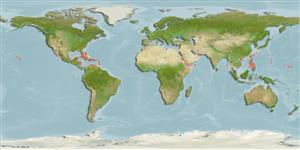Common names from other countries
Classification / Names / Names
ماع يماسا | فدارتم | Catalog of Fishes (gen., sp.) | ITIS | CoL | WoRMS
Environment: milieu / climate zone / depth range / distribution range
يسانش موب
; نيريش بآ; قمع تارييغت 0 - 1 m (Ref. 83435). Tropical; 32°N - 9°N, 90°E - 60°E (Ref. 83435)
Indo-Pacific and Western Central Atlantic.
Length at first maturity / Size / Weight / نس
Maturity: Lm ? range ? - ? cm Max length : 3.5 cm SHL يسنج صاوخ نودب / رن سنج; (Ref. 349); common length : 2.5 cm SHL يسنج صاوخ نودب / رن سنج; (Ref. 349)
Used as food by coastal populations of oceanic islands in the West Pacific (Ref. 349). Very common in the upper part of shores, often in crevices and pits of rock benches, or on branches of littoral trees overhanging the water. Moves up and down the shore in correlation with the prevailing high water level of the tide and can withstand heat and desiccation for long periods (Ref. 349). Nocturnal. Grazes on surface film of very fine marl particles, detritus, algae, flagellates, diatoms and nematodes (Ref. 96894).
Life cycle and mating behavior
غولب | لثم دیلوت | یزیر مخت | اه مخت | Fecundity | )ورال ( دازوت
Members of the order Neritopsina are mostly gonochoric and broadcast spawners. Life cycle: Embryos develop into planktonic trocophore larvae and later into juvenile veligers before becoming fully grown adults.
یلصا ذخآم
عجارم | هدننك گنهامه | ناراكمه
Poutiers, J.M. 1998. (Ref. 349)
NCUI زمرق تسرهف رد تيعضو (Ref. 130435)
ستياس رظن زا تيعضو (Ref. 108899)
Not Evaluated
Not Evaluated
یناسنا هدافتسا
تاليش – يريگ يهام: يراجت
| FishSource | Sea Around Us
اهرازبا
رتشيب تاعالطا
Age/Sizeدشرنزو - لوطلوط - لوطيسانش تخير)ورال ( دازوتيناوارف
يتنرتنيا عبانم
Estimates based on models
Preferred temperature
(Ref.
115969): 25.2 - 28.9, mean 27.7 (based on 945 cells).
یريذپ بيسآ
Low vulnerability (10 of 100).
تميق هقبط
Unknown.
